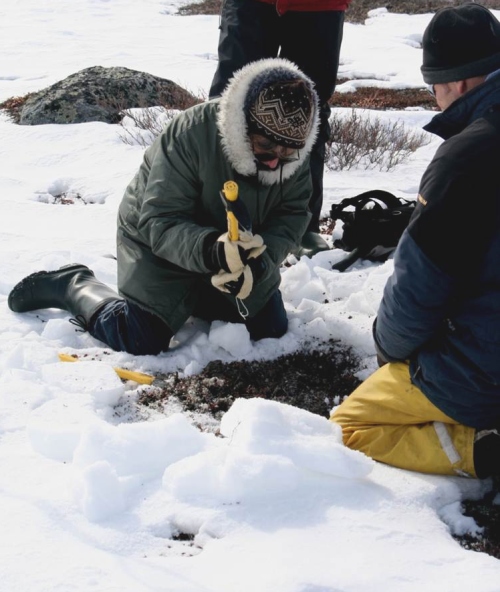Building materials may impact Arctic tundra
June 17, 2014
Share
By Anne Craig, Communications Officer
Virginia Walker (Biology) and her research team have revealed how common additives in building materials (nanoparticles) could possibly disrupt populations of microorganisms found in Arctic soils.
These commonly used building materials include paint that’s resistant to mold and mildew, insulating materials, longer lasting concrete and windows that reduce heat loss. The addition of these nanoparticles to the soil can affect seasonal change in fungi and bacteria.
 Virginia Walker removes soil samples from the Arctic tundra.
Virginia Walker removes soil samples from the Arctic tundra.“Through this research we have seen that four different measures of soil analysis point to the same result: the addition of nanosilver interferes with normal seasonal change in the Arctic tundra,” says Dr. Walker.
Dr. Walker travelled to the Tundra Research Station in Daring Lake, Northwest Territories with Queen’s researcher Paul Grogan to collect soil samples for the research. Nanoparticles were then added to the soils in her Queen’s lab and the temperature was altered over a period of three months in order to mimic a change in seasons from winter (-20 C) to summer (15 C) in the Arctic.
The contribution of research and development expertise from the biological instrument company Qubit Systems, located in Kingston, allowed the monitoring of soil respiration during these temperature shifts.
Once the summer conditions were over, the researchers examined the biochemical properties of the organisms, including DNA sequences. What the researchers found was significant.
Bacteria were generally more susceptible than fungi to the engineered nanoparticles, and the population of some beneficial plant-associating bacteria suffered. In contrast, some fungi were quite resistant to
 Virgina Walker
Virgina Walkernanosilver, including those known for their antioxidant properties. Such information can help the scientific community understand how nanoparticles impact living organisms.
“Having visited the Arctic, I knew the vast, stark beauty of the landscape and it became important to try to protect it,” says Dr. Walker. “We already know that traces of flame retardants have found their way to the Arctic. This research is critical to the Arctic ecosystem.”
Joining Dr. Walker on the research team were Niraj Kumar (Queen’s), Vishal Shah (Dowling College) and Gerry Palmer (Qubit Systems).
These findings were published in the most recent issue of PLOS One.